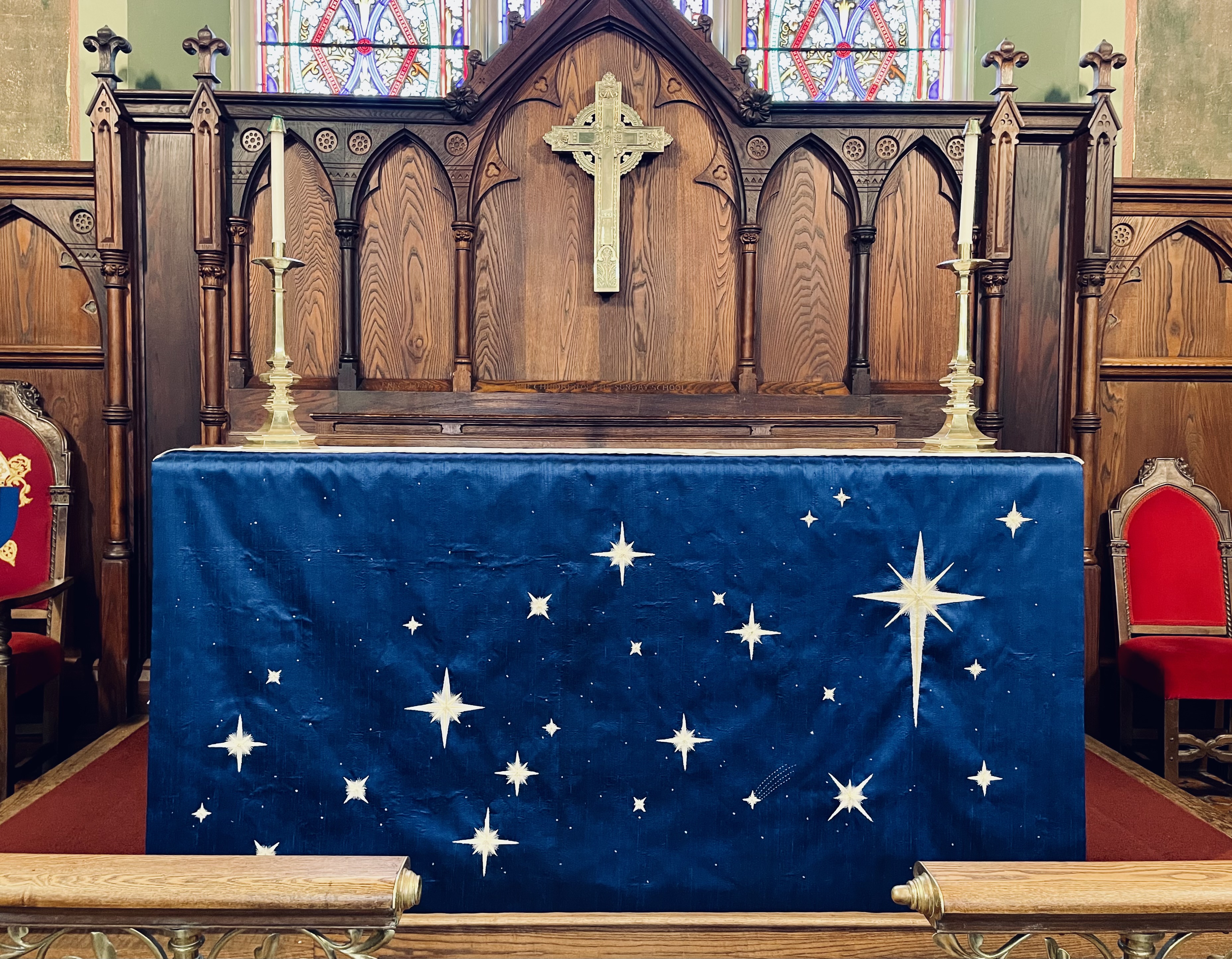1 Advent.C.21
Luke 21:25-36
The Rev. Melanie McCarley
In the midst of the frenetic activity defining much of this time of year there are few activities more centering, more peaceful and (indeed) more hopeful than to reach for the stillness bestowed upon us when we contemplate the night sky. In truth, it is the same sky into which the shepherds looked and wise men gazed. It is the sky which, as we are reminded in the Gospel lesson for this morning, heralds signs of importance easily missed should we confine our view to the horizontal and ignore the vertical.
Today a bit of the joy which heralds this special season of the church year can be found in our new set of Advent paraments (paraments is a liturgical word referring to the hangings which you see on the altar and pulpit—the stole, which I am wearing, is a vestment). These paraments are a gift of the family of John Lamb, given in his memory.
The paraments are a new color for us at St. Paul’s. Blue. Why blue? Well, this beautiful color hearkens back to that night sky—but its origins can be found in the annals of church tradition—and, as you know, we Episcopalians are quite fond of our traditions! Liturgical scholars will tell you that in the English rites of the 16th century there were no definitive colors assigned for the season of Advent—all that was specified was to use the “best” of what belonged to the church. In fact, colors used ranged from black to white to red to purple—and, of course, blue. England was the location where the use of liturgical blue was most common. Over time, the use of the word “Sarum” blue was employed—associating the color with the rites used in Salisbury—but liturgical enthusiasts will tell you this is not the case—and that blue really was used in the rites of Lichfield, Exeter and most notably, Westminster.
Suffice it to say, the liturgical colors of the church were somewhat haphazard, until the Oxford Movement in the 19th century which led to a revival of some of our most cherished liturgical traditions—candles, processions and vestments, to name but a few. Ever since the Victorian Age, the use of liturgical blue for Advent has been spreading throughout the Communion. All Saints’ Anglican Church in Rome has been using it since 1897 as has Westminster Abbey, York Minster and other churches here in North America.
Colors—they are a feast for the eyes—a reminder to us of something new that is to come. And, as purple has traditionally heralded a penitential season; blue conveys something else—the color that you see here—not so dark as to be confused with black, but not so bright that it veers into the range of electric blue; this blue (chosen with great deliberation by the Paraments committee, made up of Maggi Lamb, Ginny Graham, Karen Gorton, Liesl Gilman and Olivia Hurlock) it is a color of solemn joy and of hope. It is a color denoting seriousness, certainly, but something more—a calm expectancy and hope of what is to come.
In the blue of the night sky stars shine. Stars are lights, shining in the darkness—they are therefore, perfect symbols of Christ, the Light of the world, the Bright Morning Star, promised to a world in travail. What’s more, stars give direction, they show the way—they lead us where we need to go. They are hope in God’s glimmering parament of the night sky. If you look closely at the paraments you will see that in addition to the fabric stars, there are threads of silver and gold, as well as tiny Swarovski crystals which glimmer in the light.
As you look at the altar frontal and pulpit fall, my hope is that you will see, reflected in them some of the expectation and drama of this time in our liturgical year—a time in which we are reminded that signs are to appear in the sun, the moon, stars and the heavens. It is this time, Jesus tells us, in which we are to “stand up, and raise our heads, because our redemption is drawing near.” This time, to which our Savior refers isn’t looking backward to the birth of our Savior, but is searching ahead to the second coming of the Son of God. Advent is a season calling us to look both backward as well as forward to the birth of the Messiah and his Second Coming.
Paraments lend drama to our liturgy; what’s more, they are an expression of delight in the worship of God. It is with gratitude that we will bless these works of art, created by the skilled hand of the liturgical artist, Christina Laberge.
Embroidered in these lovely paraments are past hope and future prophecy—poetry, written by thread and needle which speaks to our heart during this holy time of year. A gift of hope and praise to God. With this in mind, it seems fitting to close with portions of a poem, this one called “Star” written by Ann Weems, from her book Kneeling in Bethlehem. She writes:
What I’d really like to give you
is a star . . . .
Brilliance in a package,
something you could keep in the pocket of your jeans
or in the pocket of your being.
Something to take out in times of darkness,
something that would never snuff out or tarnish,
something for wonderment,
something for pondering,
something that would remind you of
what Christmas has always meant:
God’s Advent Light into the darkness of this world…
With the generosity of the Lamb, Gilman and Cracknell families, this morning we are blessed with the gift of stars, urging us to lift our heads and look to the sky and prepare for the hope which is coming into the world, the very Son of God, Christ our Lord. In Jesus’ name. Amen.
